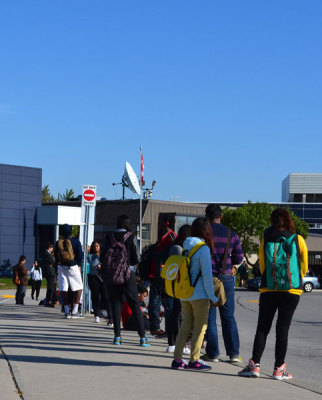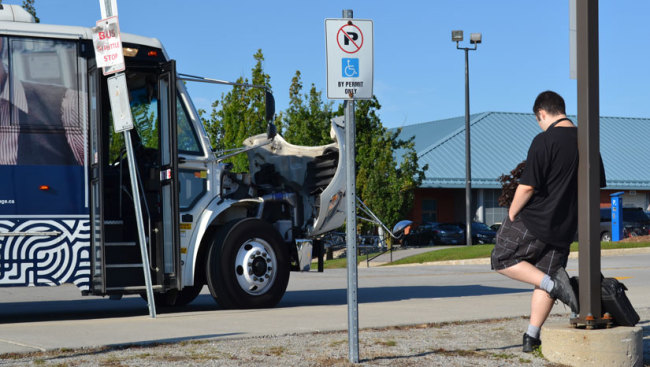SU and college scramble to fix shuttle bus mess

“We could fix [the shuttle service] tomorrow, but with a huge cost that nobody can afford. That’s the big issue. It’s money,” said Ian Marley, Sheridan’s VP of student affairs and enrollment management. (Chris Coutts / The Sheridan Sun)
STORY BY CHRIS COUTTS
Some arrive late. Some have to leave early. Some even miss their class altogether.
The shuttle service to Sheridan’s three campuses has been experiencing delays and backlogs since the first day of fall classes, and the college’s administration and Student Union are unclear on how to effectively resolve the problems.
The college will be installing student card readers on each shuttle bus at the end of October, which will provide insight on how people are using the buses. But a lasting fix to the problems will be easier said than done.
“Ultimately, it’s cost,” said Ian Marley, vice-president of student affairs and enrollment management, the college administrator who oversees the shuttle bus program. “We could fix it tomorrow, but with a huge cost that nobody can afford. That’s the big issue. It’s money.”
The two shuttle buses Sheridan started running last fall cost both the college and Student Union about $283,000 each annually.
Hearing complaints of backlogs and packed shuttle buses this fall, Marley approached the college executive team to fund a third bus to run only during peak times, from 7 to 10 a.m. and 3 to 7 p.m.
The third bus costs around $800 per day and is covered entirely by the college. Marley felt he could not wait for the Student Union to approach its council with the idea. The money for the third bus comes from the college’s reserve funds, and Marley said he’s working to figure out how to fund the third bus to operate full-time.
“Maybe one of the initial mistakes was having it be free. I don’t know,” said Marley. “I think we’re going to find a way to keep it going, and find a way to keep it very affordable.”
The shuttle service was developed as a three-year pilot program, starting last fall. Prior to launching it, research was conducted to determine how the service would be used, specifically looking at where students live and what campus they attended.
“Most of the demographics showed that students lived closer to the campus they attend,” said Marley. “The theory was there would not be a big need for students to go between campuses,” he said.
“The research was probably flawed on our part,” said Marley. “The sole purpose [of the shuttles] was to go between classes, or for students in residence to use it to get to the campus where they’re going to school. I don’t think we anticipated the number of students who use it to commute to school.”
Now forced to play catch up, the Student Union and school administration plan to install student card readers on each bus by the end of October. Students will have to tap their oneCARD on the reader when they board, which is used to verify the rider is from Sheridan as well as logging how they use the service.
“What we’re going to use the oneCARD for is to collect stats on ridership,” said Aesha Brown, Sheridan’s oneCARD manager. The statistics will be compiled in to reports of who is taking the bus and what program they’re in, what time they’re taking the bus, where they’re going and how many riders there are on any given bus.
“We can then use that to better improve the services for the shuttle bus,” she said.

The card reader will be connected to a Google Nexus tablet, using software called Heartland Campus Solutions developed by U.S.-based Heartland Systems. Brown estimates each card reader will cost “a couple hundred dollars,” while the reader’s software is the same as what is used at pay-for-print stations throughout Sheridan.
The data should also provide clarity on whether improvements could be made along with adding more buses to the rotation.
“I’m hoping we get good data in October so we can make more efficient use of the existing buses,” said Marley. “I think just running them in loops is not the best way to do it.” Marley used the example of a potential express shuttle between Trafalgar and HMC or Davis as a fix.
The idea of a bus fare hasn’t been looked at yet, as it hinges on the data that will be collected. If a fare is determined to be necessary, Marley said it would need to be less expensive than city transit.
“Before we had [shuttles], students were using public transit, and I know that’s not the best solution,” said Marley. “But the college, right now, can’t afford to just keep throwing money at it. We don’t have the money. Everybody’s in financial constraints everywhere in the province, so we just can’t keep throwing money at it.” He considers himself lucky to have obtained the money for the third bus.
Marley hopes that by beginning of the winter semester the college will have a plan to tell students about how and when the shuttle problems will be resolved, if they’re not already solved.
Jenna Pulver, Sheridan’s Student Union president, sees the backlogs and delays largely as a result of the program’s increased popularity.
“This year, during orientation and even recruiting, I think it was used as a marketing tool,” said Pulver, comparing this year’s orientation to last year’s when the buses weren’t in operation. She also used the example of a student taking a GO bus to HMC from Toronto and then taking the shuttle to Trafalgar instead of using public transit. It’s pretty common, she said.
“That was something that we weren’t necessarily expecting, so we didn’t think that there would be this high volume on the buses.”
Like Marley, Pulver is waiting for the data to be reviewed before making any lasting decisions on managing the problems with the shuttles.
“Until we’re able to find a real, genuine data-based solution, I’ve been telling students to plan ahead,” said Pulver. “We know that it’s a really popular service, so when you’re able to, try to take the bus one before what you actually needed to, and bring some books to do some studying.”
She also tells students to dress for the weather, especially with winter approaching. Pulver said students should have a backup plan such as being aware of public transit routes to their campus.
She points out that a line-up system is now being used at the bus stops to prevent people rushing the bus door to make it on.
Pulver guesses that eventually the number of full-time buses in use will need to increase to four, as well as modifying the routes they use.
She is confident that more buses will be available for the start of the fall 2015 semester, but hopes at least one more full-time bus will be in use by the winter 2015 semester.
Without some sort of increased revenue generation, Pulver sees the SU being able to fund a potentially doubled shuttle service for a year or two at most before their reserve funds run out. Pulver was unable to say how that revenue would be generated, though she’s reluctant to increase Student Union fees and leans more toward the addition of an ancillary fee.

The Student Union, Ancillary Services and Student Affairs will meet in late October and start to make sense of the data they’ve collected from the card readers.
In the meantime, their next meeting is Oct. 14. Student Union representatives will be polling students at the shuttle stops in the coming weeks to make themselves more aware of the types of issues that need to be brought up at the Oct. 14 meeting.
Pulver said the Student Union is working on better communication via social media and email with students about their progress on improving the service. The Student Union will also will have new signs with bus schedules posted at each of the stops by next semester.
“While students might want [changes] tomorrow, I think it’s serving students better to do it the right way rather than just the quick fix,” said Pulver. “Every student that comes up to us, we’ll talk to them and give them some advice. It’s not always loved, but we’re doing our best.”




